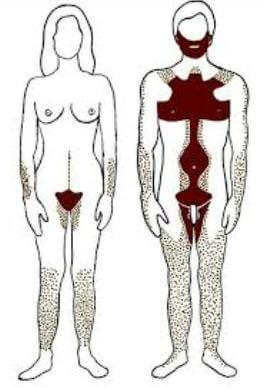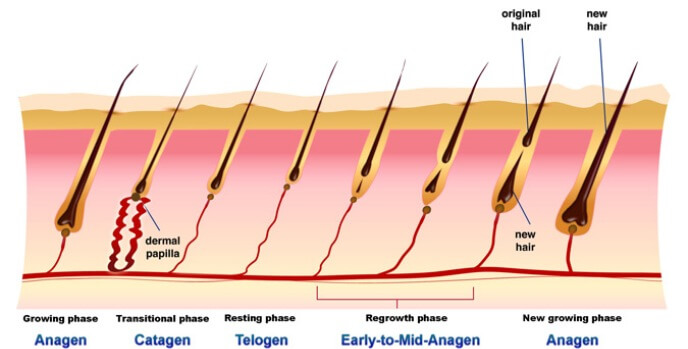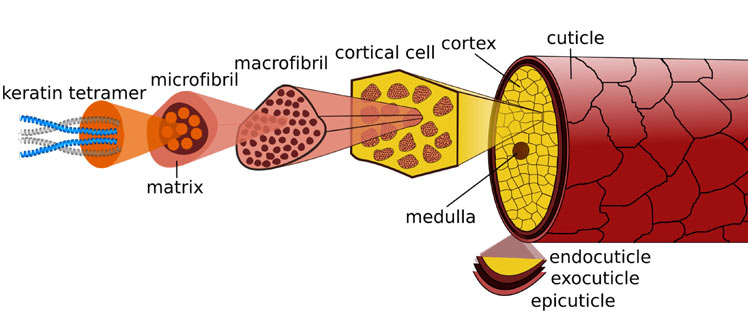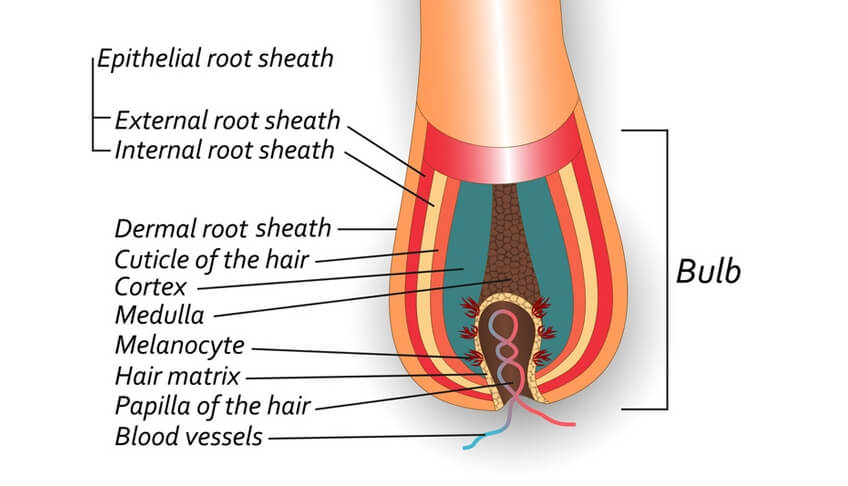Applications of Hair Science
The understanding of human hair is important when studying hair loss and hair transplant. Basic hair science includes histology, anatomy, function, biochemistry, and the hair cycle. We will try to explain all these in a comprehensive way.
Application in Hair Transplant
The bulge in the middle of the hair follicle contains stem cells. It is the most important part in follicle growth and regeneration. During hair transplant this segment of the graft must be well preserved. In FUE, when too small a punch is used, the extracted follicle may deprived of bulge tissue. In "Hair Cloning", the dermal sheath of the follicle is cultured in medium. The multiplied tissue is then injected into the skin to induce new hair formation. The stem cells in the bulge is multi-purposes. Hair follicle transplant had shown to return skin color in a skin disease called "vitiligo". The average healthy hair fiber diameter is 0.08mm or over. Below 0.04mm the hair fibers are too thin to achieve visual coverage of the scalp
Application in Hair Loss Treatment
Many treatments are being developed to stimulate the stem cells: new hair follicles can be formed; even white hairs can turn black. 5 α reductase converts testosterone into DHT. This enzyme is located in the Sebaceous Glands. Dr Inaba (Japan) believes that over consumption of animal fat swells the sebaceous gland, increases the amount 5 α reductase and DHT, leading to earlier onset of androgenetic hair loss.
Functions And Types 0f Hair
• Primary function is to communicate information about a person's age, gender, sexual maturity, health and vitality
• Hair styles are used to identify the individual society status and to attract a mate
• Protection against heat loss
• Transmit sensory, tactile information from the environment
• Form a tough barrier to protect the scalp from scratches and ultra violet light
• Nasal hair traps air borne foreign particles before reaching the lungs
• Increases surface area for sweat evaporation
• Spreads secretion from sweat and sebaceous glands
• Eyebrows and eyelashes protect the eyes by channeling or sweeping away fluids, dust and debris.
Origins of Hair
Begin to develop by week 8 in fetal life. By week 22, all hair follicles formed. At birth there are 5 million body hair follicles - one million in the head, 100,000 being scalp hair. No new hair follicles after births. Density of scalp hair reduced when the scalps expand on growing. A scalp follicle may go through 10-20 hair cycles in a life time. Each scalp hair follicle is thus expected to last 85 years.
4 Types of Hair
1. Lanugo
The soft silky hair that covers the fetus in utero, usually shed before birth.
2. Vellus
Non-pigmented fine hair with diameter less than 0.03mm. These covers the whole skin surface except the palms and soles, and includes early miniaturized depigmented terminal hair found in Androgenetic Alopecia. Usually do not grow beyond 1cm in length.
3. Terminal hair
Longer, coarser, and pigmented hair with diameter above 0.06mm. Can grow beyond 1cm in length. Before puberty these are restricted to the scalp, eyebrows and eyelashes. After puberty secondary terminal hair develops from vellus hair in response to androgen in axillae, pubic area, and front of the chest in men ( Androgen Dependent Hair - see below ).
4. Intermediate
Diameter 0.03mm to 0.06mm, consists of early miniaturization of terminal hair in Androgenetic Alopecia.
Androgen-Dependent Hair
Androgens (male hormone) regulate changes in human hair growth. In puberty the increase production of androgen changes the childhood vellus follicles into pigmented terminal follicles in many areas, including pubic and axillary hair, beard and moustache. These are called Androgen dependent hairs.
Unfortunately androgens have the opposite effect on scalp hairs. They reverse large, terminal, scalp follicles back to small vellus pale hairs and cause balding. Scalp hairs are therefore not androgen dependent.

Hair Cycle

Human hairs do not grow all the time, but in phases or returning cycles. Different hairs would have different cycle. During a human life, the growth cycle of a scalp hair will repeat itself on average 20 times from birth on. Scalp hair cycle consists of 5 phases:
1. Anagen - the Growing Phase
• The cells in the hair root is actively producing hair
• Around 85% of all hairs are in the growing phase at anytime.
• Human scalp has around 100,000 terminal hair follicles, so only 85,000 hairs are visible
• Anagen can last for 3 to 6 years (average 3 years)
• This cycle shortens with age
• This phase determine the length of the hairs. Hairs grow around 10cm per year.
• With an average anagen phase of 3 years hairs can grow to 30cm long.
• However some people can have hairs longer than 1 meter
2. Catagen - the Transitional Phase
• At the end of the growing phase, the follicles prepare themselves for the next resting period
• The production of hair stops and the hair follicle shrinks to around 1/6th of its normal length
• Around 1-2% of all hairs are in this phase
• Catogen lasts for around 1 to 2 weeks
3. Telogen - the Resting Phase
• This phase lasts for on average 3 to 4 months
• The hairs do not grow and in a phase of resting. The old hair shafts remain attached
• Around 13% (vary from 4% up to 24%.) of all hairs are in the resting phase
• More hair in this resting phase, less hair will be visible, thus giving the impression of "thinning".
• This condition "Telogen Effluvium" is common after baby delivery, under stress, or on a crush diet
4. Exogen - the Shedding Phase
• The aged hair shaft will be released and shed from the follicle
5. Kenogen - the Hairless Phase
• In this phase the old hair was shed before the new hair starts to grow
• The follicle may remain empty for many weeks to months
• In bald men more follicles are in Kenogen
• Undesirable phase as early release of club hair without follicle re-entering into anagen means loss of hair density
Hair Follicle Anatomy
3 Distinct Structures
• Hair Shaft
• Hair Root or Dermal Papilla
• Surrounding Tissue

Hair Follicle Anatomy 1 - Shaft
3 Layers of Hair Shaft :
• Cuticle - a tightly formed structure overlapping scales. A healthy cuticle is a protective layer, and controls the water content of the fiber. Much of the shine that makes healthy hair so attractive is due to the cuticle
• Cortex - makes up most of the hair shaft, and gives hair its special qualities such as elasticity and curl. Packed with strands of keratin and pigments
• Medulla - a central hollow core found in terminal hair
Hair Shaft Components
Component |
Content % |
Remarks |
|---|---|---|
Keratin |
80%-90% |
• Formed from dead protein • Contains 20 kinds of amino acids • Provide strength for the shaft |
| Water | 10%-30% | Provide shaft elasticity |
| Lipid ( Fat ) | 10% | |
| Trace Elements | Very small Quantity | Zinc, Mercury, Cobalt, Iron, Selenium ... |
| Melanin | -- | Accounts for hair color |
Hair Follicle Anatomy 2 - Root

Hair root, alsp known as Dermal Papilla, is a tunnel-like segment of the epidermis that extends down into the dermis. It can be divided into 2 compartments :
1. Vertical Compartments
Upper Follicle( Infundibulum and Isthmus )
This part is permanent
Middle Follicle ( the Bulge )
The storage area for hair follicle stem cells that are able to regenerate the hair follicles. This part is also permanent
Lower follicle ( the bulb or suprabulbar )
This forms the dermal papilla which looks like a healthy "pear" shape. This part degenerates and regenerates with each hair follicle cycle. Here the cells are divided 23 to 72 hours to regenerate the hair follicle. This rate of proliferation is the fastest in the body.
2. Horizontal Compartments
Outmost connective tissue ( dermal sheath )
Enveloping the hair follicle, this consists of 2 layers : an outer layer called the connective tissue sheath; and an inner layer called the hyaline membrane.
Outer root sheath ( ORS )
Protect and form the growing hair shaft. Also service as source of energy for protein synthesis during hair growth. Cells found in ORS are :
• Merkel’s cell
• Langerhan cells
• Amelanotic melanocytes
Inner root sheath ( IS )
Consists of 3 layers :
• Henle's layer
• Huxley's layer
• Inner root sheath cuticle
Hair Follicle Anatomy 3 - Surrounding Tissue

Components of the Surrounding Tissue
The tissue surrounding the hair root is known as Adventitous Tissue. It is consisted of several components:
1. Arrector Pil
A muscle attaches the bulge to the skin. When this muscle contracts, it causes the hair to stand up which also causes the sebaceous gland to secrete oil. This muscle must be cut in FUE to extract the follicle.
2. Melanocytes
Contain melanosomes and synthesize melanins which account for the pigmentation of hair and skin.
3. Sebaceous Glands
Opens into the isthmus. This gland secretes sebum, a semi-fluid secretion consisting chiefly of fat, keratin, and cellular material. The sebum lubricates shaft and carries away debris generated in the follicle.
4. Fatty Tissue
Scientists have discovered that stem cells are plentiful in the fat tissue, the so called Adiposed Stem Cells (ASC). ASC has been used in cardiovascular and cosmetic surgery to generate new tissues.
Chubby Grafts vs. Skinny Grafts
A study by Beehner (2010) compared the survival of chubby grafts and skinny grafts. The differences in survival is proportional to the amount of retained surrounding tissues. Stem cells are retained in chubby grafts but trimmed away in the skinny grafts.
% growth after 19 months |
Skinny Graft |
Chubby Graft |
|---|---|---|
2-hair follicular units |
69.3 % |
88.0 % |
| 1-hair follicular Units | 48 % | 98 % |

